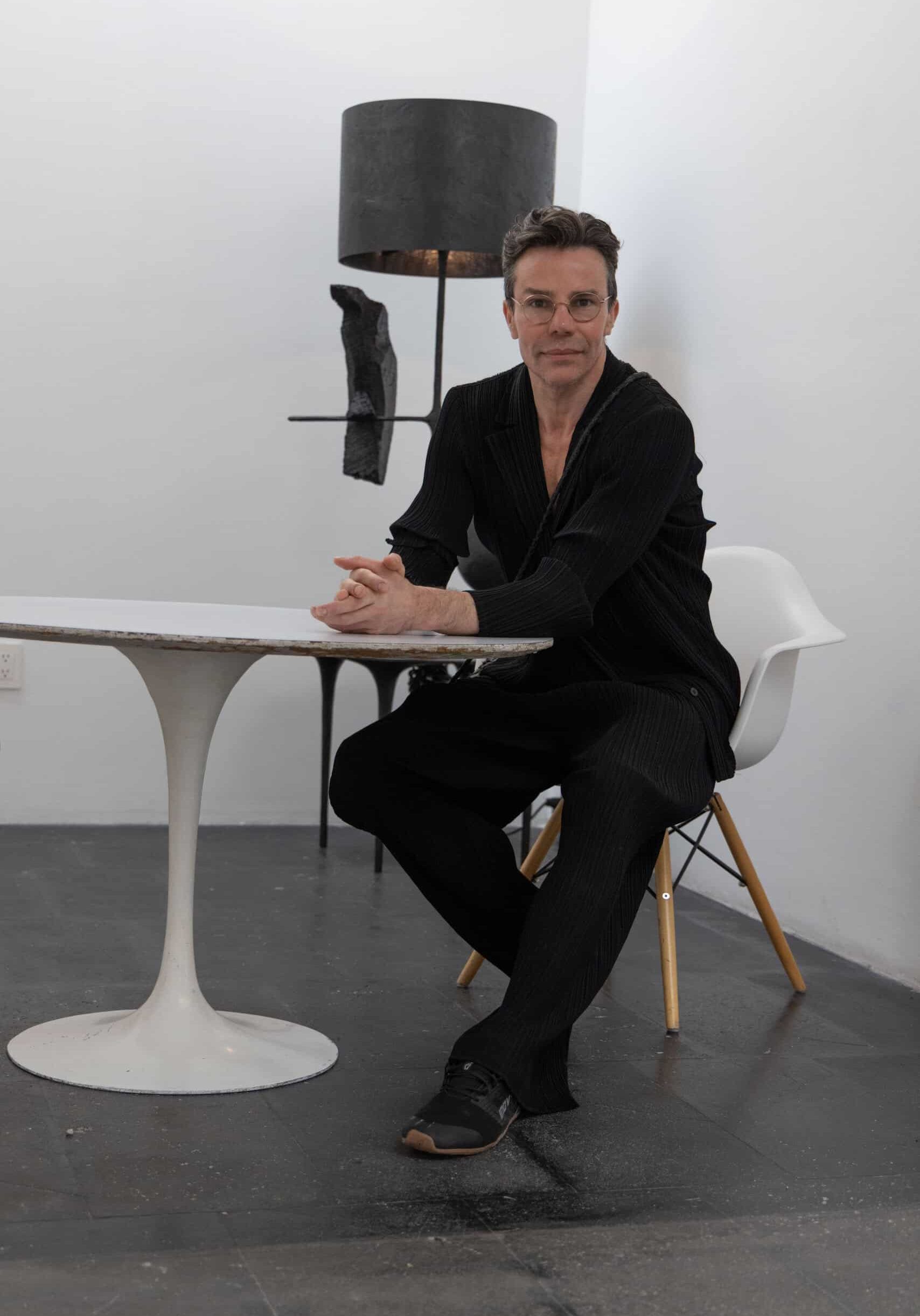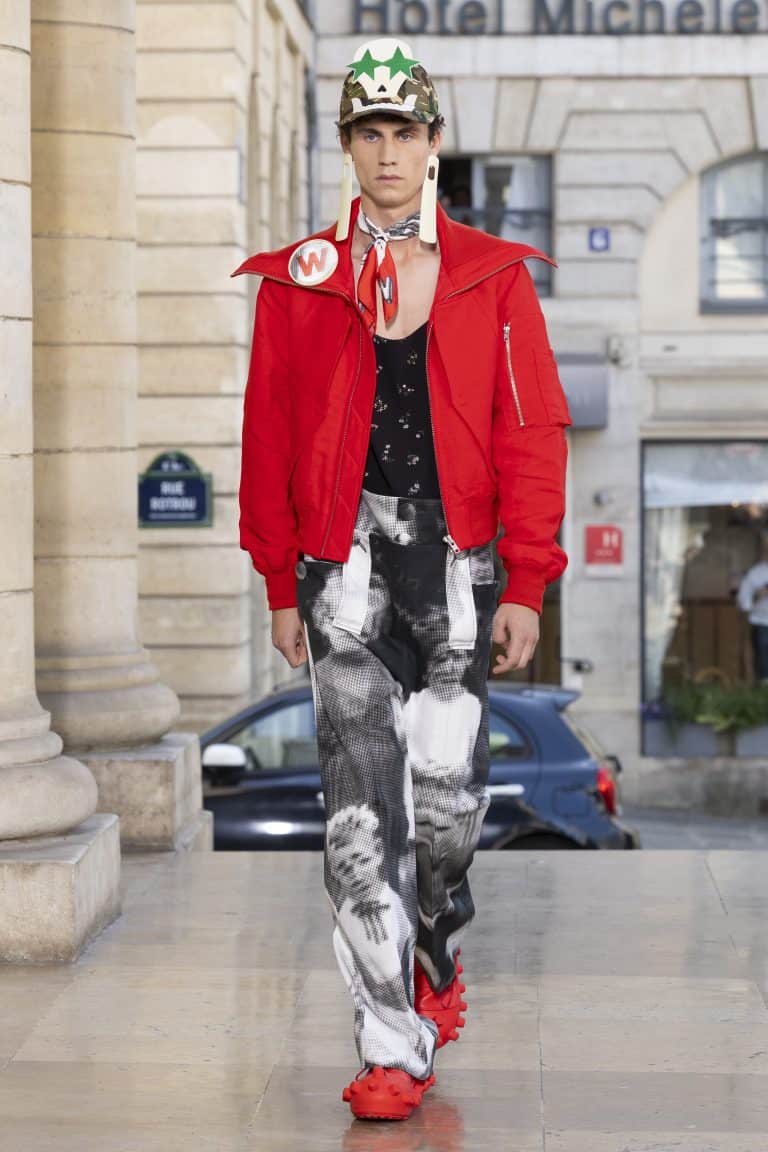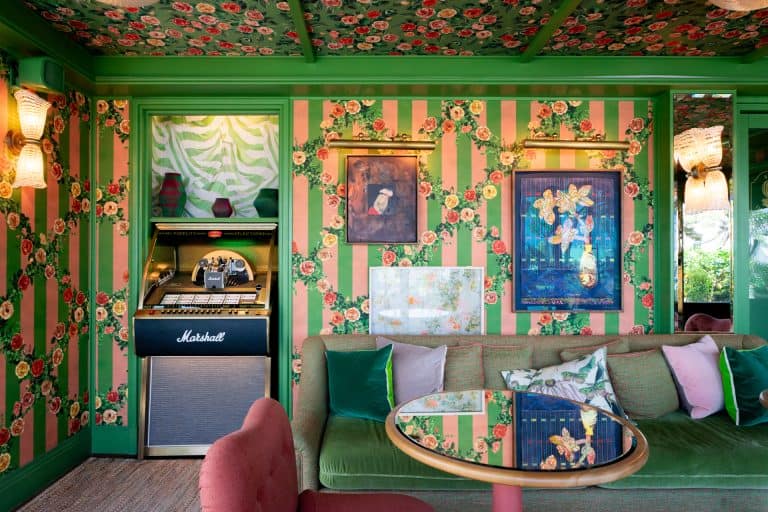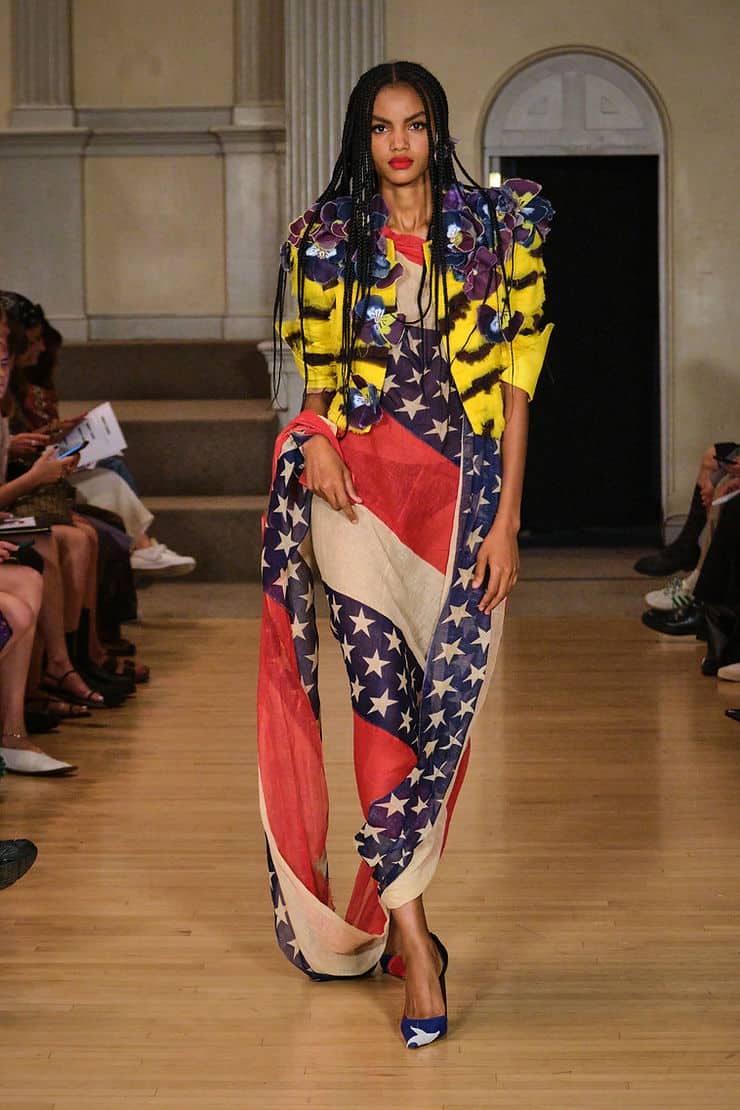
Sustainability Takes the Spotlight at NYFW 2024
In the illustrious world of style, New York Fashion Week (NYFW) has long been synonymous with glamour, creativity, and innovation. Yet in recent years, the event has become more than just a stage for the latest sartorial trends.Iit’s now a battleground in the fight for sustainability. As fashion’s elite gathered in New York from September 4th to September 11th for the 2024 edition. The growing conversation around the environmental impact of the industry could no longer be ignored. With climate change looming and consumer habits shifting, the global fashion community finds itself grappling with a critical question. How do you make fashion sustainable?
The facts are hard to ignore. The fashion industry is one of the largest polluters in the world. Contributing approximately 10% of global carbon emissions, according to the United Nations Environment Programme. Beyond its carbon footprint, the industry is also a major water guzzler, responsible for around 20% of global wastewater. Textile dyeing is the second-largest polluter of clean water globally, behind agriculture. What’s more, the rise of fast fashion—a phenomenon where brands pump out cheap, disposable clothing at breakneck speed. Has accelerated the fashion industry’s waste problem. Estimates suggest that 92 million tons of textile waste are produced globally each year. A figure that’s only expected to grow as overconsumption continues unabated.
At the heart of this problem are brands like SHEIN and TEMU. Fast-fashion behemoths that have capitalized on the desire for low-cost, high-turnover wardrobes. Their business model, reliant on overproduction and overconsumption, has created a vicious cycle of waste. SHEIN, for example, reportedly adds up to 10,000 new items to its site daily. Flooding the market with cheaply made, easily discarded garments. Consumers, lured by the promise of trendy clothes at rock-bottom prices. Often wear these pieces only a handful of times before tossing them aside, contributing to the fashion industry’s waste crisis. TEMU, another emerging player in the ultra-fast fashion space. Has similarly stoked the fires of overconsumption with its aggressive marketing and dirt-cheap products.
This overproduction is directly tied to the issue of waste. Studies show that more than half of fast-fashion garments are thrown away within a year. A significant portion of these discarded clothes end up in landfills. While some are incinerated—practices that release toxic chemicals and greenhouse gases into the environment. Even efforts to recycle clothing have proven ineffective. According to the Ellen MacArthur Foundation, less than 1% of clothing is recycled into new garments. Meaning the vast majority of fashion waste continues to pile up, year after year.
The Or Foundation’s #SpeakVolumes campaign
But there’s a growing movement pushing back against this cycle. Calling for transparency and accountability from the very brands responsible for overproduction. One such initiative is The Or Foundation’s #SpeakVolumes campaign. Launched to bring attention to the sheer quantity of clothing manufactured each year. The campaign, took over massive screens in Times Square, arguably one of the most commercially driven and consumption-focused spaces on earth. Demands that fashion brands publicly disclose their production volumes, shining a light on the often-hidden scale of their output. As the world grapples with mountains of textile waste. #SpeakVolumes seeks to hold companies accountable for their role in creating a global crisis of overconsumption and waste.
The Or Foundation’s campaign has tapped into a broader desire for transparency in the fashion industry. By encouraging brands to share this information, the foundation hopes to inspire systemic change. Forcing the industry to reckon with its addiction to cheap, disposable clothing. In a world where many brands have thrived by hiding the scale of their production. The #SpeakVolumes campaign represents a call to action that resonates with both consumers and advocates alike.
eBay and Remake
Meanwhile, others are demonstrating how fashion can thrive in a more sustainable model. This season, eBay and Remake took their own bold steps. Staging runway shows entirely made up of vintage and second-hand pieces. Their message was clear: fashion doesn’t have to be new to be chic. The eBay show, which celebrated the resurgence of pre-loved fashion. Featured curated collections of second-hand garments, showing that sustainability and style can indeed walk hand in hand. The runway was a vibrant reminder of fashion’s ability to reinvent itself. As the models strutted in archival designs and timeless vintage looks that celebrated both individuality and the environment.
Remake, a non-profit organization dedicated to pushing the fashion industry toward ethical practices. Also used its vintage runway to drive home the message that second-hand fashion is a viable and necessary alternative to fast fashion. Their show featured upcycled garments and pieces sourced from sustainable brands. Demonstrating that a circular fashion economy—where clothes are reused, reimagined, and repurposed—can be both stylish and sustainable.
These alternative runway shows were a stark contrast to the mass production and consumption that dominate much of the industry. Offering a vision of a future where fashion is built not on excess, but on reusability and creativity. As brands like SHEIN and TEMU continue to churn out clothes at unprecedented rates. Initiatives like #SpeakVolumes and these vintage runway shows serve as reminders that change is possible—and increasingly demanded.
Can glamour and sustainability coexist?
The big question I have is: can glamour and sustainability coexist? Many designers at NYFW seem to think so. Against this backdrop, NYFW 2024 offers a glimmer of hope. A growing number of designers are using their platforms to challenge the status quo. Putting sustainability at the forefront of their collections. Among the standouts is Collina Strada, whose commitment to using deadstock and recycled materials has become a cornerstone of her brand. Her playful, colorful designs are not just eye-catching. They’re a manifesto for change in an industry often criticized for its opacity and excess.
Proenza Schouler, long known for its minimalist elegance, has also embraced sustainability. Founders Jack McCollough and Lazaro Hernandez have worked to integrate more eco-friendly materials into their collections. Demonstrating that luxury and sustainability need not be mutually exclusive.
Meanwhile, Grace Ling is pioneering the use of 3D printing in fashion, creating garments with minimal waste. Her work represents the future of design—a future where innovation and environmental responsibility go hand in hand.
Emerging brands like Rentrayage, which specializes in upcycling, are proving that sustainability can also mean creativity. Designer Erin Beatty turns vintage fabrics and discarded clothing into something entirely new. Giving life to materials that might otherwise have ended up in a landfill. Melke, another designer focused on slow fashion. Advocates for biodegradable fabrics and ethical production. While Eckhaus Latta remains a leader in transparent production processes and the use of recycled materials.
NYFW 2024
Amid the growing emphasis on sustainability at NYFW 2024, Dutch designer Ronald van der Kemp marked a milestone by celebrating the 10th anniversary of his brand, renowned for its commitment to upcycled couture. This special collection showcased van der Kemp’s mastery of transforming discarded textiles and vintage materials into luxurious, one-of-a-kind pieces, proving that sustainability and high fashion can coexist. His collection not only highlighted the beauty of repurposed fabrics but also delivered a powerful message about the role of fashion in social change.
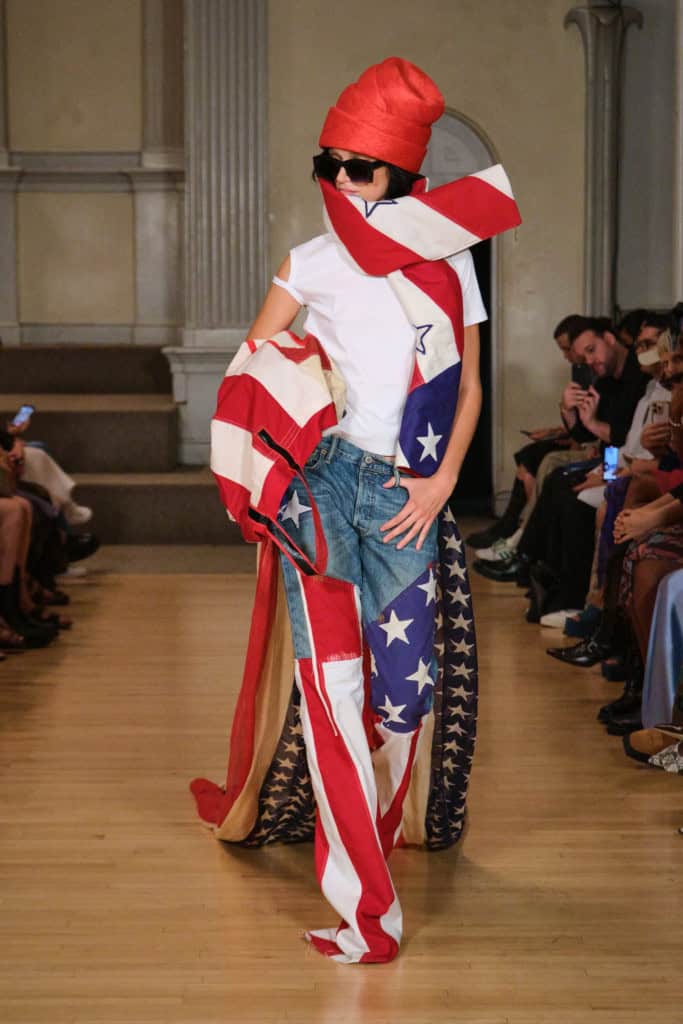
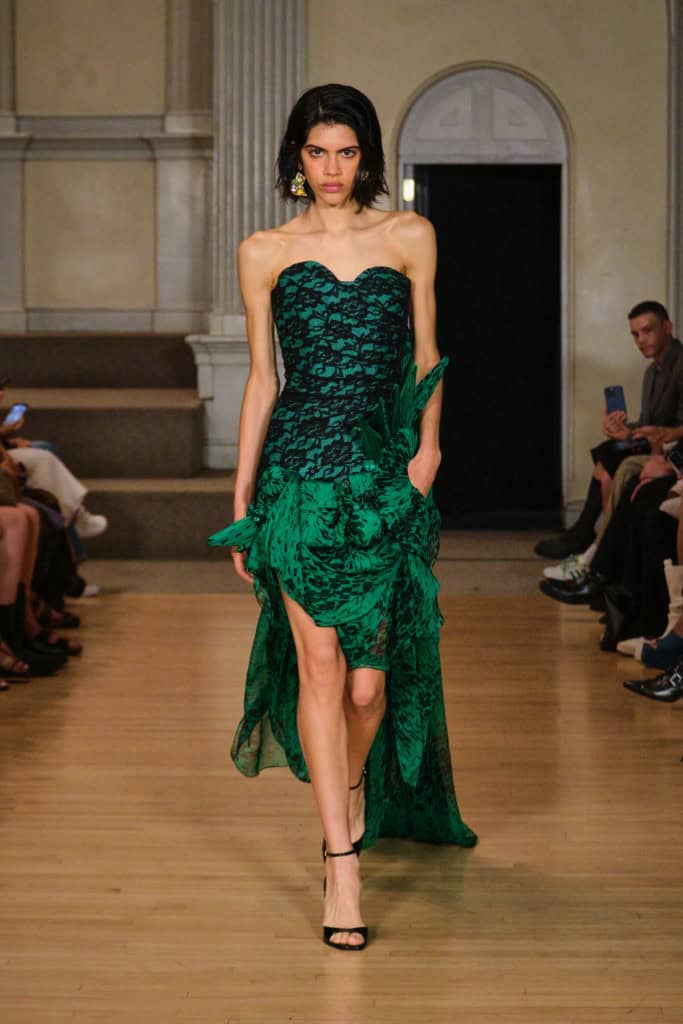
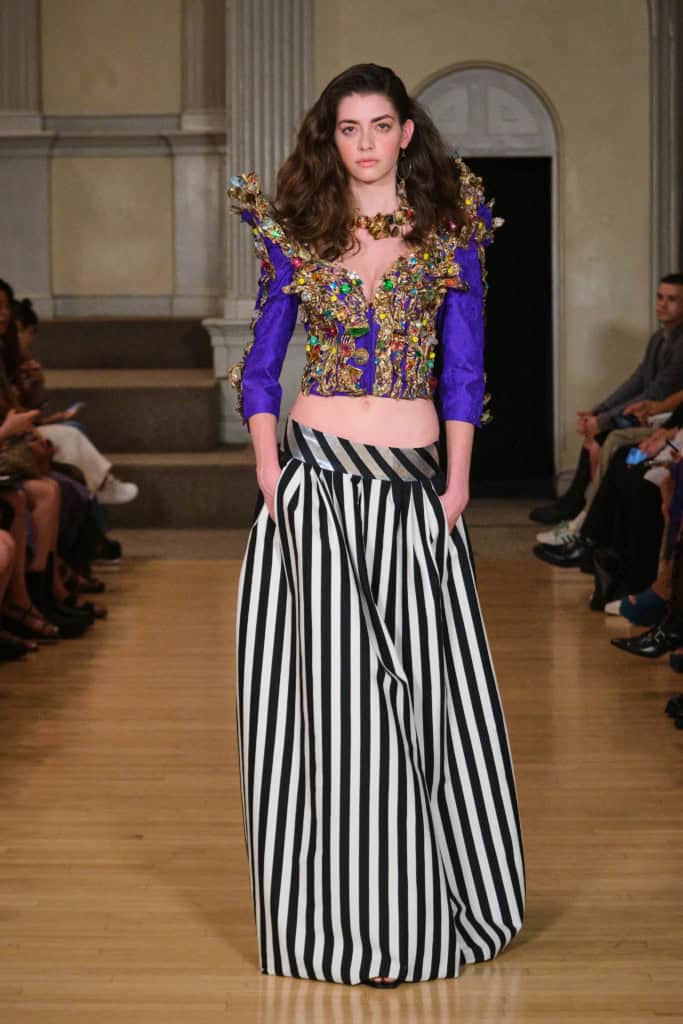
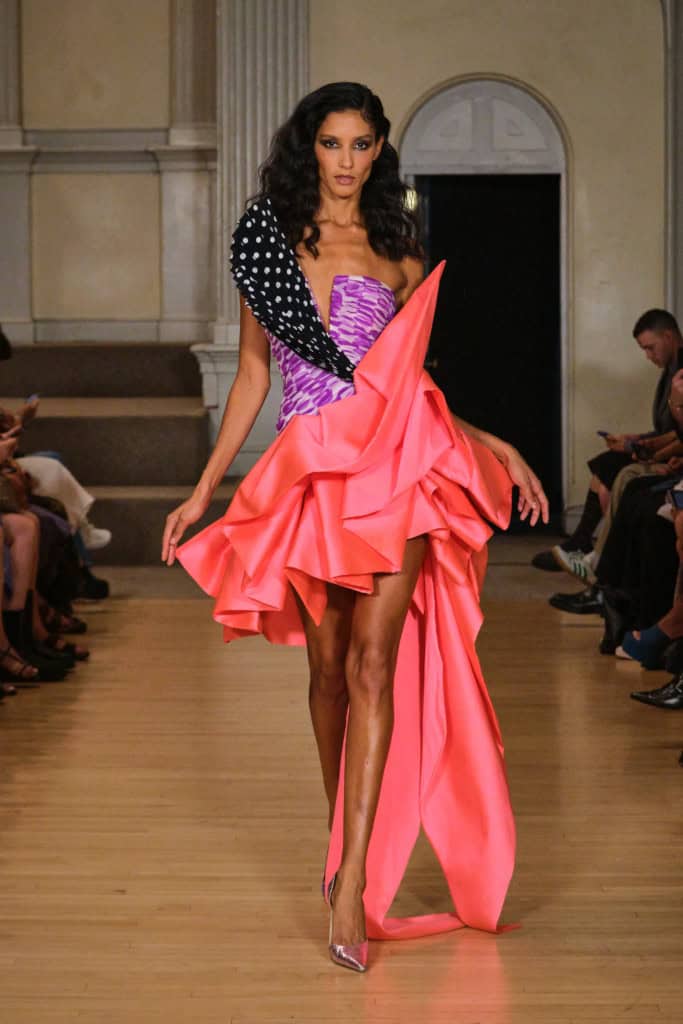
Ronald van der Kemp – SS25 Runway
In a nod to both his sustainability ethos and the current political climate, van der Kemp incorporated an American flag theme throughout the collection, championing the importance of voting and civic engagement. With bold, symbolic designs, the collection served as a call to action, reminding viewers of the power they hold in shaping the future—not just through their consumption choices, but also at the ballot box. By intertwining eco-consciousness with social responsibility, van der Kemp’s 10th-anniversary collection stood as a testament to how fashion can inspire change on multiple fronts, all while maintaining the elegance and craftsmanship of couture.
These designers are part of a broader movement that is slowly gaining momentum within the fashion world. Yet the challenge remains immense. For every Collina Strada or Eckhaus Latta, there are dozens of fast-fashion brands driving overproduction and overconsumption. Until the industry reckons with its addiction to cheap, disposable fashion, the environmental toll will only continue to rise.
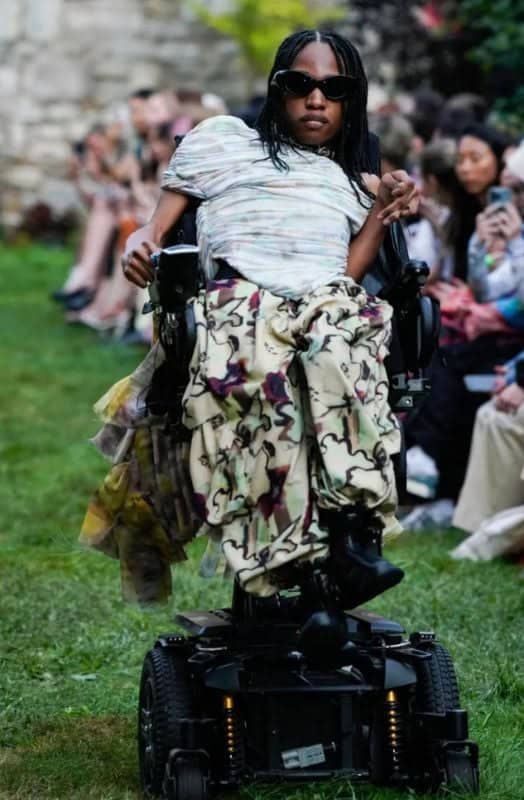
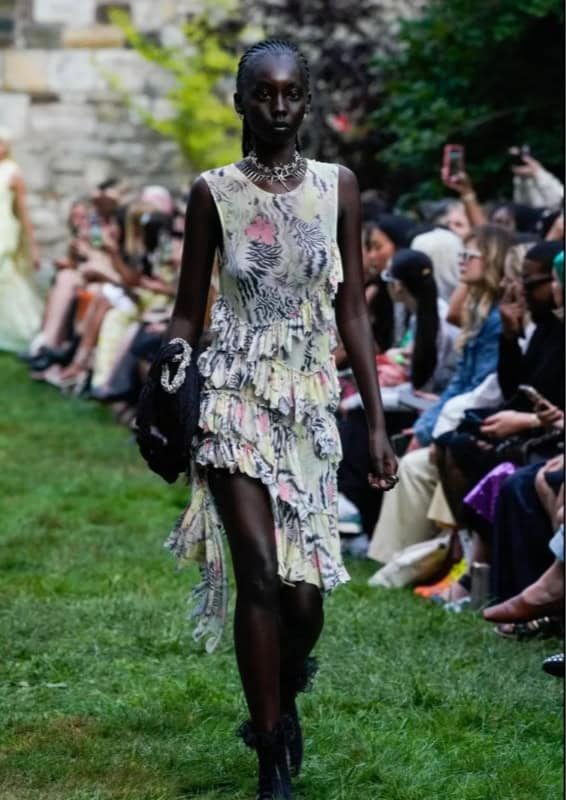
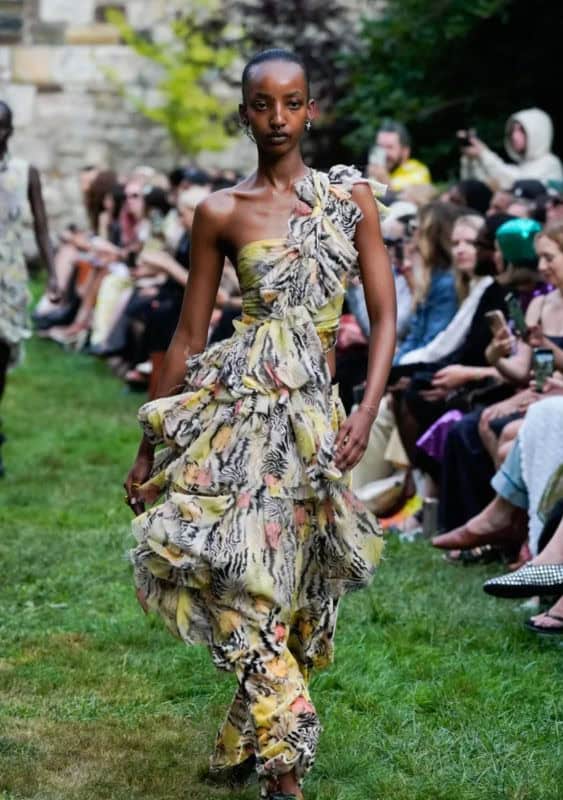
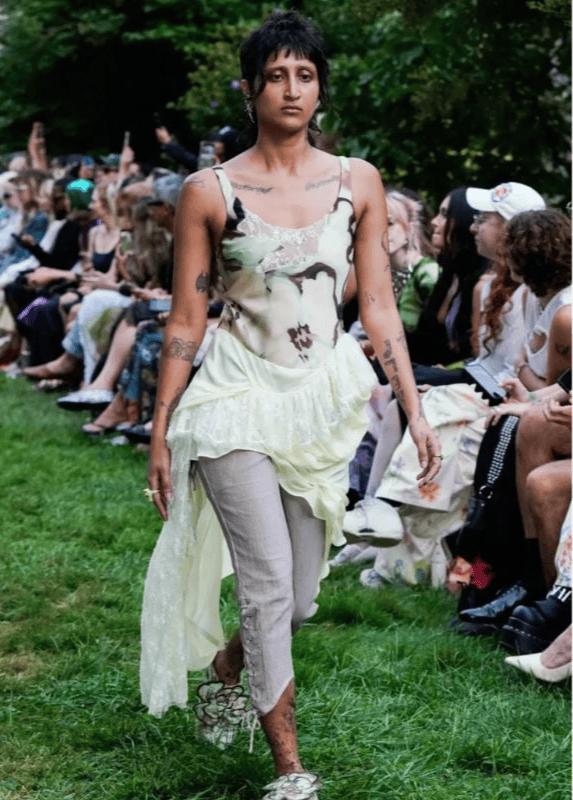
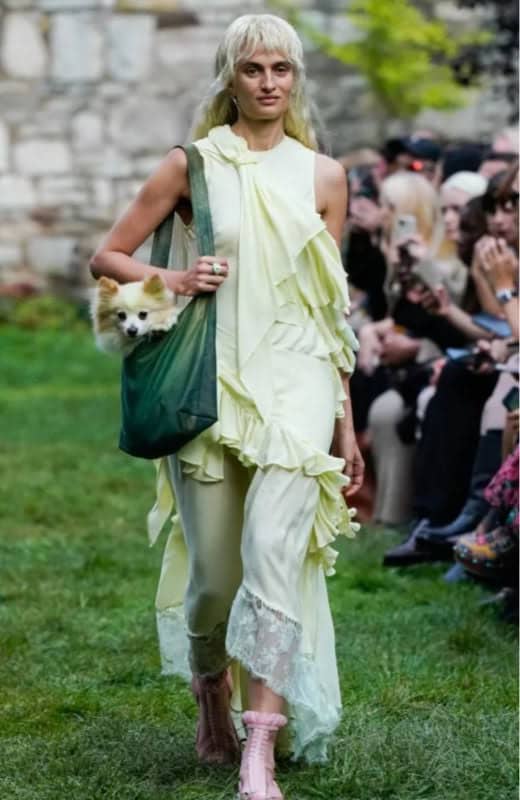
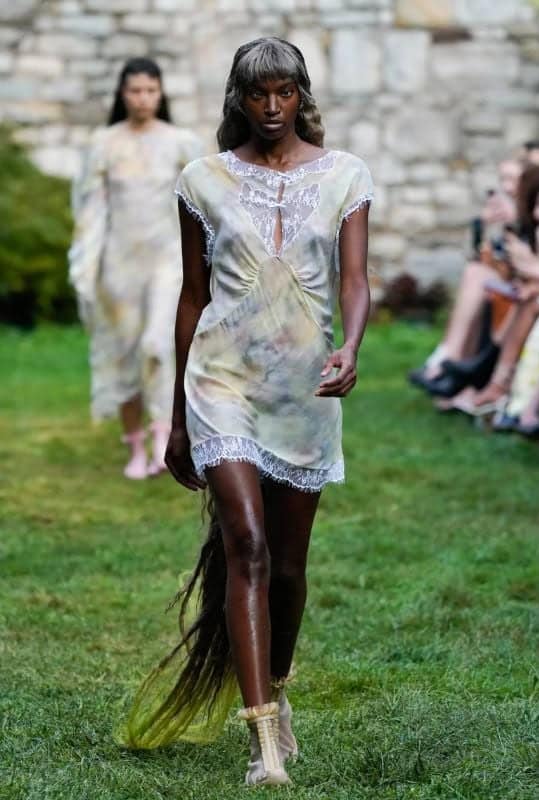
Collins Strada SS25
Another notable international contender in the NYFW sustainable fashion scene comes to the USA with a noble cause. To fuse fashion with diplomacy. As New York Fashion Week 2024 spotlighted sustainability, the Estonia Design House emerged as a powerful international voice in the movement. Having first made waves during NYCxDesign, the Estonian collective has returned to New York for a pop-up at The Canvas, showcasing a diverse lineup of 17 eco-conscious designers committed to sustainable practices featuring brands like Iris Janvier, Sile Luik, Sandra Luks, Piret Loog, and more.
In addition to the brands featured at NYFW, the Estonia Design House collective also showcases designers with a conscious ethos in mind. Ennos, known for its minimalist, timeless designs crafted from organic materials; Kelpman Textile, celebrated for its use of sustainable fabrics and bold patterns; and Triinu Pungits, whose avant-garde approach brings a fresh, artistic take on slow fashion.
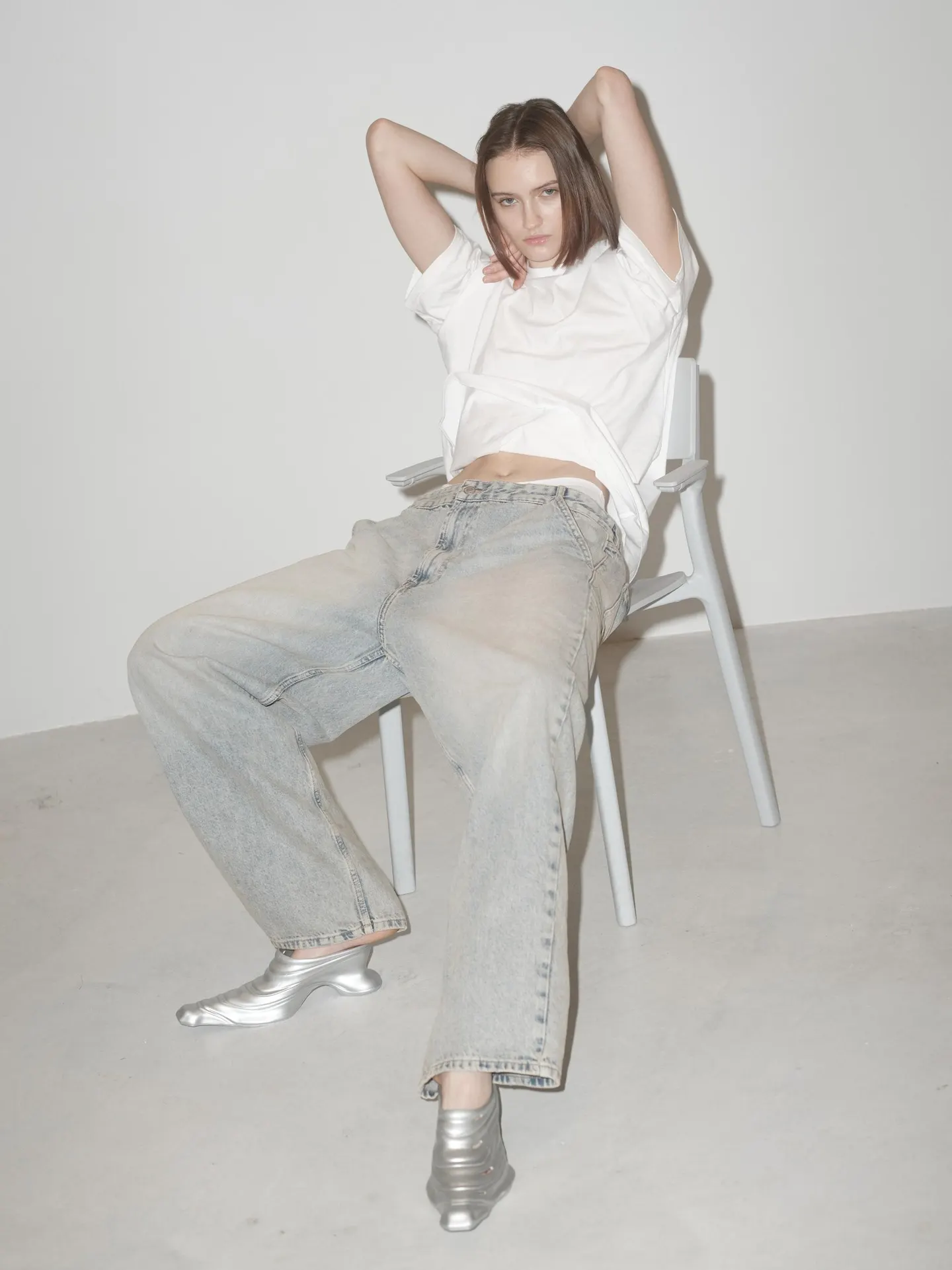
Clothing by Xenia Joost XENIA JOOST
Other designers include Tanel Veenre, who creates striking jewelry from upcycled materials, and Kristel Kuslapuu, renowned for her vibrant knitwear made from responsibly sourced yarns. Both collections emphasize ethical production, the use of natural materials, and a deep respect for craftsmanship.
Through their collaboration with The Canvas NYC, these Estonian designers are not only promoting sustainable fashion but also fostering a global dialogue on the future of eco-conscious design. Their return to New York reinforces that sustainability knows no borders, inspiring change across the fashion world through innovation and responsible creativity.
Gen Z
The good news is that consumers are beginning to demand more from the brands they support. Younger generations, particularly Gen Z, are increasingly prioritizing sustainability in their purchasing decisions. A 2023 report from McKinsey found that 67% of Gen Z consumers consider sustainability to be an important factor when buying clothes. This shift in consumer sentiment is forcing brands to adapt—or risk being left behind.
As NYFW 2024 draws to a close, the conversation around sustainability is only growing louder. From the designers on the cutting edge of eco-friendly fashion to the grassroots movements pushing for accountability, the future of fashion is being shaped by those willing to challenge its unsustainable past. For an industry that has often thrived on excess, this season’s message was unmistakable: less can be more, and fashion’s survival may depend on it.
Share this post
Patrick Duffy is the founder of Global Fashion Exchange, a company catalyzing positive impact through strategic consulting roadmaps focusing on supply chain transparency, worker rights, responsible production for B2B as well as consumer facing programming and community building focusing on aligning people or communities with the SDGs.
Experience developing networks and activating ideas, guiding creative teams globally, and working with institutions like the Victoria and Albert Museum and UNESCO, and iconic spaces such as Federation Square Melbourne, Madison Square Garden, Bryant Park in New York City, and The Dolby Theatre in Los Angeles.
Patrick has produced clothing swaps all over the world from, with GFX Active in over 100 countries. Each GFX event focuses on building community, education and transformational business models. Partnering with global brands, key stakeholders, and academia to help create awareness and positive impact through conscious consumption
Patrick harnesses the power of media to create positive social and environmental impact. Through storytelling, education, and advocacy, he raises awareness, inspires action, to catalyze change. By highlighting issues and solutions, Patrick creates strategic campaigns to engage audiences, influence attitudes and behaviors, and contribute to a more sustainable and just world. Additionally, Patrick is the Sustainability and Positive Impact Director of Paris based @IRKMagazine and Editor In Chief of @IRKLiving
Patrick has produced and co-curated events and marketing/PR campaigns for recognized brands across art, fashion, and tech spaces including @virginhotels @britishfashioncouncil @mspdid @moethennessy @microsoft @lagosfashionweekofficial @perutradenyc @fashionimpactfund @istitutomarangonidubai @peaceboatus @lisboafashionweek and more spanning 15 years and hundreds of events in 5 continents.
Read Next

